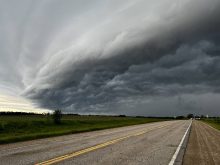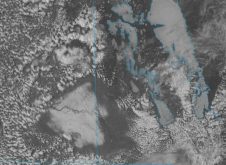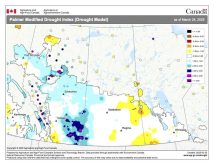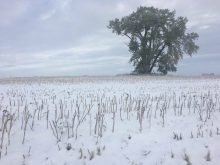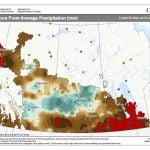To start off this week I just have to share one of the coolest weather-related websites I’ve come across in a long time.
I think it was last year when I shared a link to a website that showed surface winds across North America. It was a website that was actually created as part of an art project and used weather model data to show an animated map of wind patterns and wind strength.
Well, it seems that project has now gone global. If you go to the website: earth.nullschool.net, you will find a scalable Earth — much like Google Earth — that will allow you to see current wind direction and speed all across the Earth. You can move around the Earth and zoom in and out to see more detail — all based on weather model data. It might not be actual real-life data, but it’s still pretty close and I find that it really allows you to visualize how the air is moving around the planet.
Read Also

Thunderstorms and straight-line winds
Weather columnist Daniel Bezte discusses the strength of straight-line winds during a thunderstorm and the damage they can cause.
You’ll be able to see areas of high pressure with winds flowing out from one area, and you will definitely be able to find areas of low pressure where the winds are spiralling in towards a centre of low pressure. The page defaults to surface winds, but if you click on the word ‘earth’ in the bottom left-hand corner, a menu will pop up allowing you to make a whole bunch of changes.
I won’t bore you with all of the options, but what you should check out is how the wind patterns change as you move up in the atmosphere. You can see this by selecting different pressure levels: 1,000, 850, 750 hPa, each one representing a level higher up in the atmosphere. If you are even slightly interested in the weather I would recommend that you check out this resource. You won’t be disappointed!
Now on to my next topic, spring snowstorms. (I know — don’t talk about them and then maybe they won’t happen.)
But believe it or not, across the Prairies, March and April have seen some of the biggest snowstorms. As warm, moist air begins its yearly push northwards, cold air from the Arctic sometimes has a hard time letting go. When the two combine, we can get some truly big snowstorms. I don’t have the time or resources to check out every location across our region, so once again I’ll rely on our three main centres: Calgary in the south, Edmonton for central regions, and Peace River in the north.
For this study, I only looked at snowfall and did not take into account any combination of rainfall and wet snow, as this would mostly have been recorded as rainfall at Environment Canada stations.
Let us begin by looking at Calgary. April snow is not an unknown thing to residents of this part of Alberta. Looking back through Calgary’s weather records, I was actually very surprised at just how many snowfall days occurred during April. The biggest April snowstorm I was able to find occurred in 1932, when between April 20 and 21 an amazing 49.3 centimetres of snow fell.
Then, only one year later, a storm hit on April 15 and lasted through to the 17th. During this storm, nearly 46 centimetres of snow fell. Another 40-plus-centimetre snowstorm occurred in 1966 on April 25-27, when 45 centimetres fell.
In 2003, between April 26 and 28, 38.5 centimetres of snow fell. This storm recorded the second-largest one-day snowfall total for April, when 32.2 centimetres fell on April 26. The largest single-day snowfall total for April occurred during the 1932 storm, when on April 21 an absolutely amazing 45.7 centimetres of snow fell.
In the Edmonton region, the number of spring snowfalls is not as great as the Calgary region, but the city has still seen its fair share of large April snowstorms. The largest one occurred in 1955, when between April 18 and 20 a whopping 47.5 centimetres of snow fell. Yet another big April storm hit in 1948 when 43 centimetres of snow fell between April 1 and 3.
The third-biggest storm occurred from April 6-7 of 1991, when nearly 41 centimetres of snow fell, with over 36 centimetres falling on April 6. This is the second-largest one-day snowfall record for April. The largest occurred on April 19, 1955 when 38 centimetres fell. The most recent big snow event was in 2002 when 28 centimetres fell on April 14-15.
The Peace River region has seen a couple of big spring storms, but not many of them. The biggest I could find occurred in 1966 when from April 9-12, a total of 49.3 centimetres of snow fell. The second-biggest storm I could find for this region was in 2003 when from April 1-3 45.3 centimetres of snow fell.
So, as the stats point out, some of the largest snowstorms to hit this part of the world have occurred in April.
Are we going to see a repeat this year?
I really hope not, but as the weather goes, you just never know! So, let’s keep our fingers crossed that April ends up bringing us perfect weather and that we enter May with nice mild temperatures and soil moisture conditions just where we want them to be.




